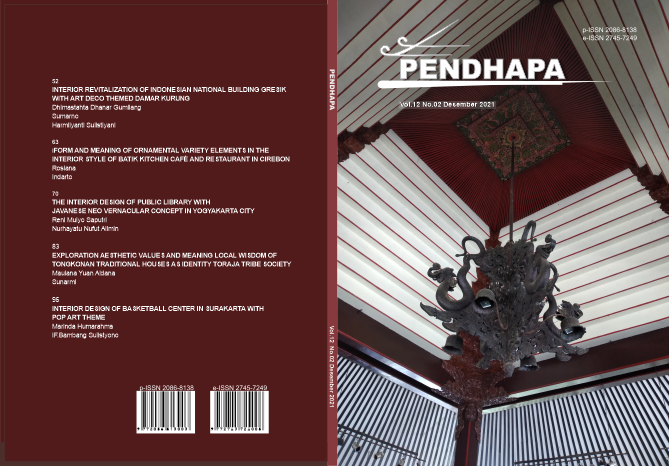Form and Meaning of Ornamental Variety Elements in the Interior Style of Batik Kitchen Café and Restaurant in Cirebon
DOI:
https://doi.org/10.33153/pendhapa.v12i2.4026Keywords:
Forms, Meanings, Decorative Elements, Batik KitchenAbstract
Batik Kitchen Café and Restaurant is a culinary-related commercial building in Cirebon. Batik Kitchen Café and Restaurant in Cirebon applies decorative elements in the form of batik to its interior style. The application of decorative elements to the interior style of Batik Kitchen Café and Restaurant is found in the elements that form and fill the space. This study aims to determine the application, decoration, and meaning of the decorations in the interior of Batik Kitchen Café and Restaurant in Cirebon. To answer the problems in the study, the interior design approach the theory of D.K. Ching, and Roland Barthes' approach to meaning. The research was conducted with a qualitative descriptive method. This qualitative research is directed at the real conditions of the research object. The data sources of this research are sources (informants), objects, records, literature, and the internet. The results showed: (1) The application of decorative elements in the form of batik was found in space; lobby area, dining room, and bar area, in the form of space-forming elements; floors, walls, and ceilings, as well as space fillers; tables and chairs, as well as interior accessories. (2) The decorative elements applied to the interior style of Batik Kitchen Café and Restaurant in Cirebon is Nusantara batik motifs which have various meanings. The application of decorative elements to the interior style of the Batik Kitchen Cafe and Restaurant in Cirebon which plays a role in introducing, promoting, and preserving the traditional and cultural values of Cirebon City.
Downloads
References
Allen, G. (2004). Roland Barthes. Routledge.
Borshalina, T. (n.d.). Anticipation in the Future Development of Trusmi Batik SMES at Cirebon Regency.
Docci, M., & Chiavoni, E. (2014). Visione, pensiero, disegni: gli insegnamenti di Francis DK Ching= Vision, ideas,
drawings: teachings by Francis DK Ching. Visione, Pensiero, Disegni: Gli Insegnamenti Di Francis DK Ching=
Vision, Ideas, Drawings: Teachings by Francis DK Ching, 48–59.
Handayani, S. (2019). Batik Trusmi Produksi Sally Giovani. Institut Seni Indonesia Yogyakarta.
Lauer, D. A., & Pentak, S. (2011). Design basics. Cengage Learning.
Nurhayati, E., & Nurhidayah, Y. (n.d.). Multicultural Value in the Traditional Islamic Boarding School, Bina Insan Mulia (BIMA), Cirebon, Indonesia. Nadwa, 13(1), 165–178.
Nursalim, A., & Sobandi, B. (2020). Revitalization of Keraton Cirebon Batik.
Ramdoni, D., Sugiharto, T., Permana, A., & Nugraha, R. (2019). Implementation of the FAST Fast Corner Detection
Algorithm (Feature Form Accelerated Segment Test) and Augmented Reality to Determine the Authenticity of
Batik Case Study (Batik Trusmi) Cirebon. Balong International Journal of Design, 1(1).
Rosenthal, M. (2016). Qualitative research methods: Why, when, and how to conduct interviews and focus groups in pharmacy research. Currents in Pharmacy Teaching and Learning, 8(4), 509–516.
Shuang, G. A. O. (2012). The commodification of place, consumption of identity: The sociolinguistic construction of a ‘global village’in rural China 1. Journal of Sociolinguistics, 16(3), 336–357.
Sumarno, S., & Indarto, I. (2018). Desain Show Room Bagi Para Perajin Rotan DS. Trangsan, Kec. Gatak, Kab.
Sukoharjo. Pendhapa, 9(2). https://doi.org/https://doi.org/10.33153/pendhapa.v9i2.2419
Sunarya, Y., & Anas, B. (2011). The aspect of identity in modern batik priangan in the context of creative industry in the city of Bandung. 3rd CELT International Seminar, 19–20.
Tresnawati, N., Saleh, I., & Wardani, S. (2020). Scientific reconstruction of local plants as the basic materials of Batik Natural Dyes. Journal of Physics: Conference Series, 1511(1), 12062.
Trihanondo, D., Endriawan, D., Haryotedjo, T., Putra, G. M., & Machfiroh, R. (2021). Redefining Cirebon batik into an environmentally friendly icon of West Java. IOP Conference Series: Materials Science and Engineering, 1098(5), 52011.
Widodo, W., Soekarba, S. R., & Kusharjanto, B. (2021). Pemaknaan Motif Truntum Batik Surakarta: Kajian Semiotik
Charles W. Morris. Sutasoma: Jurnal Sastra Jawa, 9(2), 197–210.
Downloads
Published
Issue
Section
License
Authors who publish with Pendhapa agree to the following terms:
- Authors retain copyright and grant the journal right of first publication with the work simultaneously licensed under a Creative Commons Attribution License (CC BY-SA 4.0) that allows others to share the work with an acknowledgment of the work's authorship and initial publication in this journal.
- Authors are able to enter into separate, additional contractual arrangements for the non-exclusive distribution of the journal's published version of the work (e.g., post it to an institutional repository or publish it in a book), with an acknowledgment of its initial publication in this journal.
- Authors are permitted and encouraged to post their work online (e.g., in institutional repositories or on their website) prior to and during the submission process, as it can lead to productive exchanges, as well as earlier and greater citation of published work.

This work is licensed under a Creative Commons Attribution-ShareAlike 4.0 International License.









